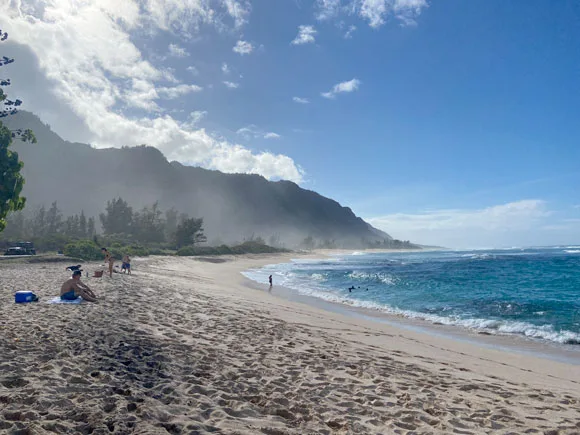
The Power of Tiny Aerosols: Understanding the Role of Giant Sea Salt in Hawaii’s Weather

Caption: Plumes of sea salt aerosol near the Ko‘olau Mountains from a large swell on O’ahu. PHOTO BY KATHERINE ACKERMAN.
Dive into the World of Giant Sea Salt Aerosol
Tiny aerosols, including sea salt, dust, and ash, may be minuscule in size, but they hold significant influence over weather and climate patterns. A recent study conducted at the University of Hawai’i at Mānoa delves deeper into one common Hawaiian aerosol, giant sea salt aerosol, uncovering that coastal areas release up to five times more particles than the open ocean.
The Impact on Cloud Formation and Rainfall
Why does this matter? These particles have a direct impact on cloud formation and rainfall, making them central players in Hawaii’s weather dynamics.
“Aerosol-cloud interactions and rainfall are among the biggest uncertainties in projections of future climate,”
“Because freshwater is essential to the sustainability of life on the Hawaiian Islands, it is imperative to accurately predict where and how much it will rain as our climate changes.”
“The day-to-day rain from cumulus clouds is critical to replenishing our fresh groundwater,”
“But the transition from cloud to raining cloud is still poorly understood, and therefore difficult to predict. We hope this research helps improve predictions of rain generated by Hawaiʻi’s tradewind cumulus clouds so that we can better prepare Hawaiʻi in this changing world.”
A New Approach to Measurement
Alison Nugent, the senior author of the study and associate professor of atmospheric sciences, along with her team, developed a lightweight and affordable 3D-printed instrument. This instrument measures aerosol size distributions and allows for more accurate sampling compared to other methods that only measure bulk aerosol concentration or mass. They attached the device to kites, fishing rods, and drones to capture data on giant sea salt size distributions across various altitudes, locations from the coastline, and different environmental conditions.
Enhancing Weather Prediction
This groundbreaking finding can be utilized to enhance numerical weather prediction models related to nearshore cloud formation and rainfall patterns across the Hawaiian islands.
“Regular in situ (in the original place) observation of clouds is difficult because of the effort involved with reaching them,”
“So instead, much of our current research has focused on the giant sea salt particles that Hawaiʻi’s clouds form on, and understanding the specific mechanisms that influence how these particles are produced, and where they are able to travel after production.”
The Journey from Shore to Sky
When waves break on the shoreline, a mist comprised of water droplets and giant sea salt aerosol is created. These particles are then carried by onshore winds towards the mountains.
“Anyone who goes to the beach in Hawai’i has probably seen these processes in action,”
“Even when you can’t see them anymore, the particles are still there, moving with the wind, and eventually up to the clouds.”
The Coastal Connection
“We identified the coast as a major source of giant sea salt particles which is important in understanding how they impact our coastal clouds,”
“Their large size means they fall out of the atmosphere a lot faster than other aerosol types, so identifying their production locations is really important to quantifying their potential impacts on the local atmosphere.”
The researchers also discovered that wave heights were the primary indicator of giant sea salt aerosol concentrations.
“This observation feels intuitive—larger waves breaking along the shore will produce more ocean mist,”
“However, most computer models have been using wind speeds to predict sea salt aerosol concentrations over the open ocean, and almost none recognize coastlines as an additional source.”